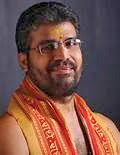Spiritual Import of Religious Festivals : 11.10.
Chapter-11.The Sport of the Infinite-10.
( Rasa-Lila message given on the 22nd of October, 1972.)
Pain is not the truth of existence. So it is the Ananda, the Supernal Beatitude, Beauty, magnificence and the lustre of God that has revealed itself in this historical epic movement of the Supreme into the temporal realms as Bhagavan Sri Krishna. Impossible it is for the human mind to understand what the Rasa means, because it is not meant for man to understand.
It was God dancing to His own tune. This is the eternal Tandava or cosmic dance which is connotative of all the manifestations – personal, social, political and spiritual. It is the remedy that is administered to the soul of man to cure him of the illness of Samsara. As Sage Suka puts it towards the end of the description of the Rasa Panchadhyayi, "This is the remedy prescribed for the 'illnesses of the heart'." 'Hridroga' is the word used, which means illness of the heart, which has only one remedy, viz., the love of God. Our heart disease is our central illness.
It does not necessarily mean physical illness of the heart which we call blood pressure, heart attack, etc., but the Samsara-consciousness, the bondage of the soul. Kama, Krodha and Lobha are the heart attacks, primarily speaking. And these are the essential bondages of the soul. The cure of Samsara is supposed to be contained in this hidden import of the Sport of Divinity in the mortal realm. God dances eternally. It may be Siva's dance, Rudra's dance or Krishna's dance.
We may call it by any name or appellation we like. It is the Spirit persisting through matter and interfering with every step of the process of evolution in the work of transforming matter into Spirit, converting externality into the universal Beauty of God and insisting that the mortal should become Immortal, because the birthright of man is Divinity.
Swami Krishnananda
To be continued ...





Comments